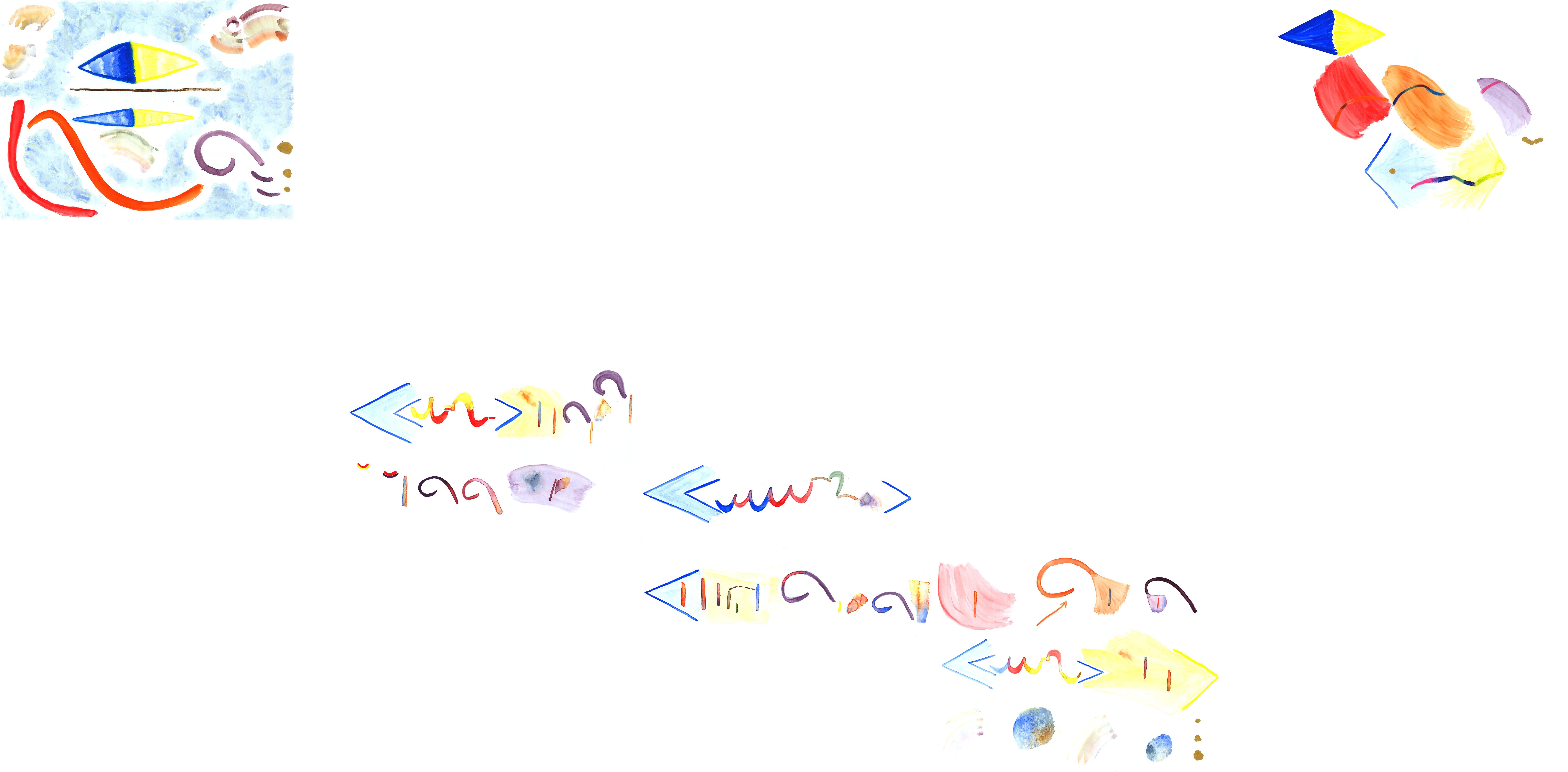click and hover over dots;
grab and drag over images
I deliberately chose large sheets (18" x 24") for the score, because this open canvas forced me to realise
the music in bold shapes and vivid colours that defy the self-contained form of the Sonata in question.
More important, these shapes combine with colours to objectify the musical gestures essential to the work.

To simplify the music for translation to movement, and to externalise my understanding of
the Ligeti Solo Cello Sonata, I painted this graphic score. Originally conceived as
the interpretive common denominator for the project, this score became the linchpin of
the creative process. Together with choreographer, and later composer, we established
two perspectives, which were consistent with the two-movement duality of the Sonata.
These perspectives both met the original musical line with the physical line of movement,
and also interpreted the geometric lines of the graphic score through the musical lines
of fresh composition. The final performance coalesced in three parts: the choreographed Ligeti Sonata, a panel discussion with collaborators on creative process, and finally, the premiere of the new piece Lines for Gage (choreographed as structured improvisation).

Differences in graphic representation between the Capriccio (above) and Dialogo (below) reflect opposite interpretive
approaches, motivated in turn by the basic contrast of musical character. The virtuosic streaks of the Capriccio
demand the literal realisation of line, while the lyricism and harmonic shading of the Dialogo suggest the abstract.
While the Capriccio top and its bottom alter-images show the overall linear progression of the music, the Dialogo
shows the musical transition of perspective from representation of a unified space to sequential representation.
click and hover over dots;
grab and drag over images

Lines for Gage Performance:
Reverberations
1:36
LSCS Performance:
Low Stretto
3:25
Panel Discussion:
Differences in Approach
'...a sense of embodiment that each of us has taken on board...this sense of ownership that is important in this collaboration; I think this is what the graphic score does, it gives you an amount of ownership...'
-choreographer Harriet Macauley
LSCS Performance:
Curves
3:55
Lines for Gage Performance:
Vertiginous Tremolo
4:22
Lines for Gage Performance:
Dynamic
1:36
Panel Discussion:
Graphic Score as Unifier

 Panel Discussion-
Panel Discussion-
Pizzicato: Coincidence?
Both the Ligeti Solo Cello Sonata and Lines for Gage begin with pizzicato, as composer Dan Ehrlich notes in the excerpt from the panel discussion below. Shown above and at left are the two ways that plucked sliding (pizzicato glissando) is represented in the graphic score. These images come from the opening of the Dialogo, and the reprise of this melody at the midpoint of the Capriccio, (from the first page Dan selected for his piece) respectively. That I was conflicted about how to represent pizzicato provided the opportunity to include two distinct visual representations reflecting two very different musical contexts. And yet both of these images grow in volume, a fundamental attribute of a pizzicato sound.
LSCS Performance:
Dialogo Opening
Lines for Gage Performance:
Opening
:25
:32
.jpg)
Panel Discussion:
Task & Gesture
LSCS Performance:
Movement Trigger
& Silence Frame
8:23
Gesture: Music-Art-Dance
LSCS Performance:
'Tunnel' Section
6:48
Panel Discussion:
Project Trajectory
Interdisciplinary progression:
Music - Art - Dance
Event progression:
Ligeti Solo Cello Sonata - panel discussion - Lines for Gage
Choreographic progression:
[interspersed solos - duet contact work] - [seated in dialogue - falling to the Earth - climbing to the Heavens]
Panel Discussion:
Space as Questioning
Lines for Gage Performance:
Distance & Silence
2:22
' a lot of questioning for me with no answer, and that was that space...a sense of questioning each time you listen.'
-choreographer Harriet Macauley
Panel Discussion:
Risk in Choreographic Style
'...a background...which requires a lot of risk, the use of dynamics, a lot of fluidity, there's a change of tempo, so you get the sense of this drive in the Capriccio; we started with floor patterns, looking at this circular motion...someone kept pushing: how high could you get and how far could you go? and so I worked with this sense of two bodies coming together and meeting or colliding...this constant rotation with Gage being the pivot, so it's this dialogue between physical bodies as well as sound.'
-choreographer Harriet Macauley
LSCS Performance:
Capriccio Opening
Lines for Gage Performance:
Suspension & Resolution
5:53
3:39
Risk was a conscious choice and a creative decision, first invoked through
the creation of the graphic score as the basis of music-dance correspondence, implicit in the participation of the cello in the dance, manifested in the complexity of the Capriccio choreography, and at the fore of the Lines for Gage structured improvisation.